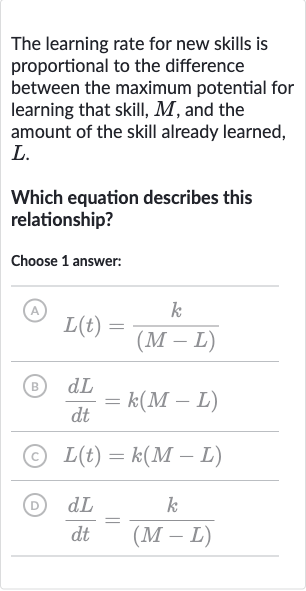AI tutor
Full solution
Q. The learning rate for new skills is proportional to the difference between the maximum potential for learning that skill, , and the amount of the skill already learned, .Which equation describes this relationship?Choose answer:(A) (B) (C) (D)
- Identify Relationship Equation: The problem states that the learning rate is proportional to the difference between the maximum potential, , and the amount already learned, . This suggests that the rate of change of with respect to time, , is directly proportional to . We need to find an equation that represents this relationship.
- Eliminate Incorrect Options: Looking at the options, we can eliminate and because they do not represent a rate of change over time; they are expressions for without any differentiation. We are looking for an equation that involves , which is the derivative of with respect to time, indicating a rate of change.
- Select Correct Option: Option (B) states that , which aligns with the description given in the problem. It shows that the rate of change of with respect to time is proportional to the difference , with being the constant of proportionality.
- Analyze Option D: Option (D) suggests that is equal to divided by , which would imply that the learning rate decreases as the difference increases. This is contrary to the problem statement, which says the learning rate is directly proportional to , not inversely proportional.



